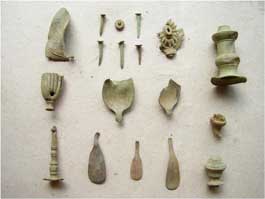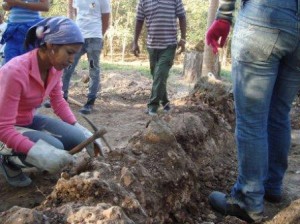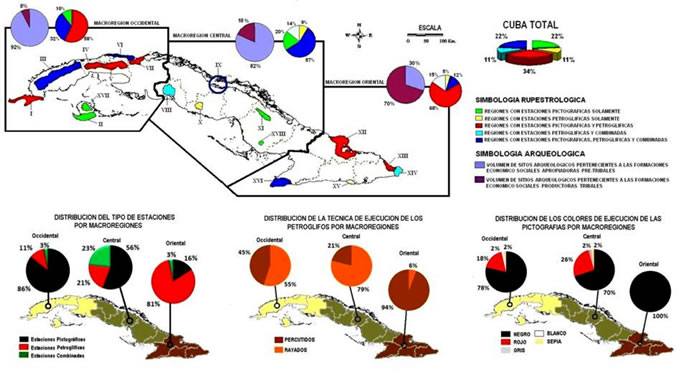An archaeological census performed by the Anthropology Institute within the Cuban Science, Technology and Environment Ministry has found that the human presence on the island hypothetically dates from between 8,000 and 10,000 years ago, local media here reported on Sunday.
The project that has been under way in Cuba for the past two years incorporates the research and experience of archaeologists, experts, historians, institutions and hobbyists and the officials heading it say it is expected to wrap up in January 2014.
Cuba has about 3,200 Aboriginal archaeological sites located, mostly in the provinces of Pinar del Rio and Villa Clara, according to preliminary results of a census Archaeology on the Island, other housing strong links were found in the eastern provinces according to other sources.
The research, to be completed this year found nearly 1,000 new Aboriginal sites and demonstrated that regions of Pinar del Rio (west) and Villa Clara (center) have the highest density of these sites in the country, with 500 each.
The research uses maps with precise coordinates on the municipality level with the aim of providing a general idea about the aboriginal archaeological situation in the country, and it also includes a series of elements to allow the production of a more finished product: the Aboriginal Archaeological Atlas of Cuba.
In compiling Cuba’s human settlement history, the indigenous peoples are catalogued as pre-agropottery (before the 3rd century B.C.E.), proto-agricultural (2nd century B.C.E.) and agropottery (5th century C.E.) to encompass their diverse sociocultural connections.
Some of the sites were human dwelling places, as surmised by the presence of food remains and hearths, along with other evidence of tools and trash, all of which show that those sites were inhabited by ancient communities for some time, the experts say.
“Others functioned as rest stops, since they are areas … without evidence of prolonged habitation made by … mobile communities that moved periodically but repeated their stays, as well as inhabited caves,” said Jimenez Santander, project director.
He also said that there are signs of the use of caves for ceremonies, burials, cave painting sites, shell workshops to make vessels and other objects, as well as evidence of chipped flint, tools and assorted work rubbish.
Sources: EFE/InternetPhotos/www.thecubanhistory.com
Cuban Archaeologists found presence from 8000 to 10000 years
The Cuban History, Arnoldo Varona, Editor
ARQUEÓLOGOS CUBANOS ENCUENTRAN PRESENCIA DE 8000 a 10000 años EN CUBA.
Un censo arqueológico realizado por el Instituto de Antropología en la Ciencia, Tecnología y Medio Ambiente Ministerio cubano ha encontrado que la presencia humana en la isla data hipotéticamente de entre 8.000 y 10.000 años atrás, la prensa local informó aquí el domingo.
El proyecto que ha estado llevando a cabo en Cuba a los dos últimos años, incorpora la investigación y la experiencia de los arqueólogos, historiadores, expertos, instituciones y aficionados y los funcionarios epígrafe dice que se espera concluir en enero de 2014.
Cuba tiene cerca de 3.200 sitios arqueológicos aborígenes ubicados, en su mayoría en las provincias de Pinar del Río y Villa Clara, según los resultados preliminares de un censo de Arqueología de la isla, se encontró que fuertes eslabones de vivienda en las provincias orientales, según otras fuentes.
La investigación, que se completará este año encontró cerca de 1.000 nuevos sitios aborígenes y ha demostrado que las regiones de Pinar del Río (oeste) y Villa Clara (centro) tienen la mayor densidad de estos sitios en el país, con 500 cada uno.
La investigación utiliza mapas con coordenadas precisas en el nivel municipal, con el objetivo de proporcionar una idea general de la situación arqueológica aborigen en el país, y también incluye una serie de elementos para permitir la producción de un producto más acabado: el Atlas Arqueológico aborigen de Cuba.
En la elaboración de la historia de los asentamientos humanos de Cuba, los pueblos indígenas son catalogados como pre-agropottery (antes del siglo tercero antes de Cristo), proto-agrícola (segundo siglo aC) y agropottery (siglo quinto CE) para abarcar la diversidad de sus conexiones socioculturales.
Algunos de los sitios eran moradas humanas, como conjeturado por la presencia de restos de comida y hogares, junto con otras pruebas de las herramientas y la basura, todos los cuales muestran que los sitios estaban habitadas por comunidades antiguas desde hace algún tiempo, dicen los expertos.
“Otros funcionaban como áreas de descanso, ya que son zonas … sin evidencia de ocupación prolongada realizada por … las comunidades móviles que se desplazaban periódicamente, pero reiteraron sus estancias, así como las cuevas habitadas”, dijo Jiménez Santander, director del proyecto.
También dijo que hay indicios de la utilización de las cuevas para ceremonias, entierros, sitios de arte rupestre, talleres de shell para hacer vasos y otros objetos, así como las pruebas de pedernal astillado, herramientas y surtidos basura trabajo.
Sources: EFE/InternetPhotos/www.thecubanhistory.com
Cuban Archaeologists found presence from 8000 to 10000 years
The Cuban History, Arnoldo Varona, Editor



 CUBAN ARCHAEOLOGIST found presence from 8000 to 10000 years * ARQUEÓLOGOS CUBANOS encuentran presencia de 8000 a 10000 años.
CUBAN ARCHAEOLOGIST found presence from 8000 to 10000 years * ARQUEÓLOGOS CUBANOS encuentran presencia de 8000 a 10000 años.

